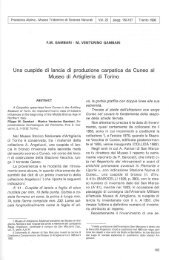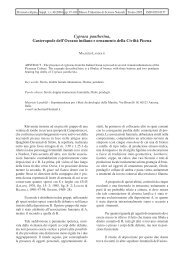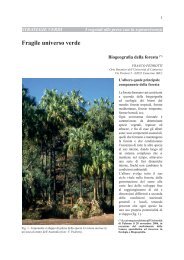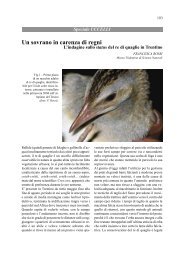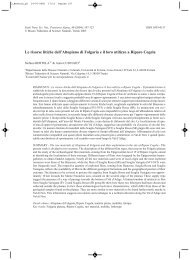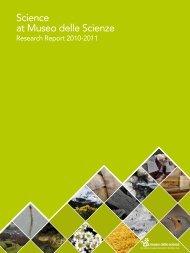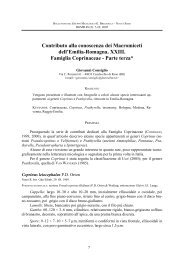Progetto HIGHEST - Relazione Finale - Museo Tridentino di Scienze ...
Progetto HIGHEST - Relazione Finale - Museo Tridentino di Scienze ...
Progetto HIGHEST - Relazione Finale - Museo Tridentino di Scienze ...
Create successful ePaper yourself
Turn your PDF publications into a flip-book with our unique Google optimized e-Paper software.
Tutti i tratti sono stati or<strong>di</strong>nati secondo il criterio gerarchico in<strong>di</strong>cato da Strahler (1957) e <strong>di</strong><br />
ognuno sono state misurate lunghezza e pendenza ogni 100 m <strong>di</strong> quota. È stato inoltre calcolato il<br />
rapporto <strong>di</strong> biforcazione (Rb), che consiste nel rapporto tra il numero <strong>di</strong> tratti <strong>di</strong> un dato or<strong>di</strong>ne e il<br />
numero <strong>di</strong> tratti <strong>di</strong> or<strong>di</strong>ne successivo (Strahler 1984). Dei 53 tratti fluviali in<strong>di</strong>viduati, 42 sono<br />
risultati <strong>di</strong> 1° or<strong>di</strong>ne, 8 <strong>di</strong> 2° or<strong>di</strong>ne e 3 <strong>di</strong> 3° or<strong>di</strong>ne (Tab. 4). Sulla base dei dati riportati in tabella 1<br />
si può osservare che, nel sottobacino del Noce Bianco, all’aumentare dell’or<strong>di</strong>ne gerarchico (u)<br />
aumenta la lunghezza me<strong>di</strong>a dei tratti (Lu), mentre <strong>di</strong>minuisce il loro numero (N). Questa relazione<br />
tra numero/lunghezza/or<strong>di</strong>ne corrisponde a quanto atteso (Strahler 1984), mentre nel sottobacino<br />
del Careser la lunghezza me<strong>di</strong>a dei tratti <strong>di</strong> 3° or<strong>di</strong>ne è inferiore a quelli <strong>di</strong> 1° e 2°. Questo è dovuto<br />
alla presenza sul Rio Careser, a quota 2600 m s.l.m., <strong>di</strong> un bacino artificiale che ne interrompe la<br />
continuità, per cui il tratto a valle della <strong>di</strong>ga viene attribuito al 1° or<strong>di</strong>ne. Per quanto riguarda il<br />
rapporto <strong>di</strong> biforcazione, che consente una rapida stima del numero <strong>di</strong> tratti in cui me<strong>di</strong>amente si<br />
sud<strong>di</strong>vide un corso d’acqua <strong>di</strong> un determinato or<strong>di</strong>ne, i valori me<strong>di</strong> calcolati per i due sottobacini<br />
rientrano nei range tipici <strong>di</strong> sistemi fluviali naturali che, secondo Strahler (1984), vanno da 3 a 5. La<br />
lunghezza complessiva del reticolo idrografico del Noce Bianco è <strong>di</strong> 34,5 km, <strong>di</strong> cui 19 compresi nel<br />
sottobacino del Noce Bianco e 15,5 km in quello del Careser.<br />
a<br />
b<br />
m s.l.m.<br />
3100-3000<br />
3000-2900<br />
2900-2800<br />
2800-2700<br />
2700-2600<br />
2600-2500<br />
2500-2400<br />
2400-2300<br />
2300-2200<br />
2200-2100<br />
2100-2000<br />
2000-1900<br />
m s.l.m.<br />
3100-3000<br />
3000-2900<br />
2900-2800<br />
2800-2700<br />
2700-2600<br />
2600-2500<br />
2500-2400<br />
2400-2300<br />
2300-2200<br />
2200-2100<br />
2100-2000<br />
2000-1900<br />
0 10 20 30 40 50 60 70<br />
%<br />
3° or<strong>di</strong>ne<br />
2° or<strong>di</strong>ne<br />
1° or<strong>di</strong>ne<br />
0 10 20 30 40 50 60 70<br />
%<br />
Fig. 5 ‐ Distribuzione altitu<strong>di</strong>nale degli or<strong>di</strong>ni fluviali nei due sottobacini Noce Bianco (a) e Careser (b).<br />
43



